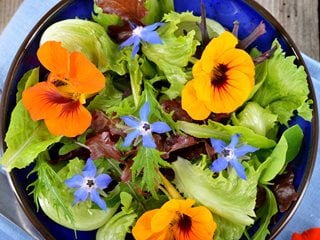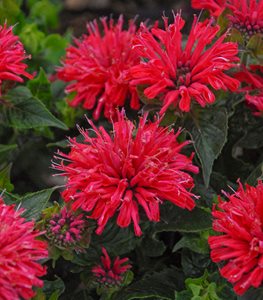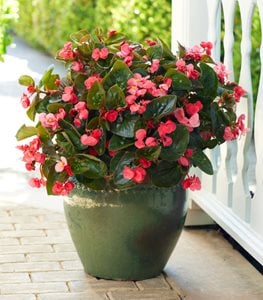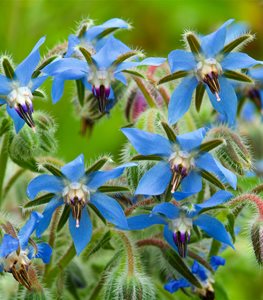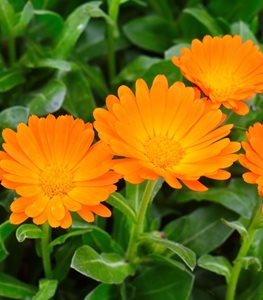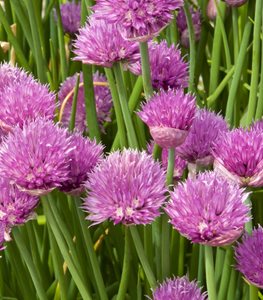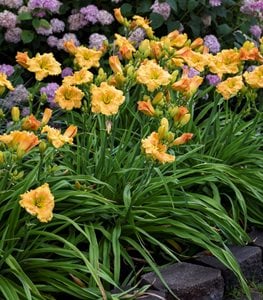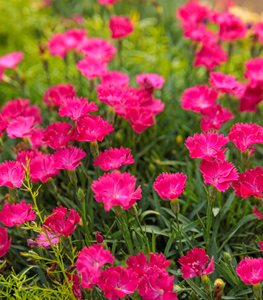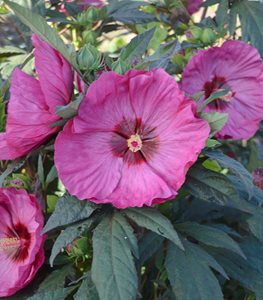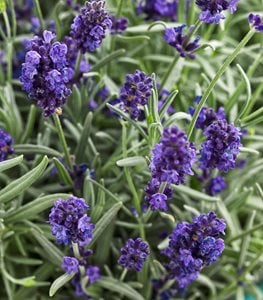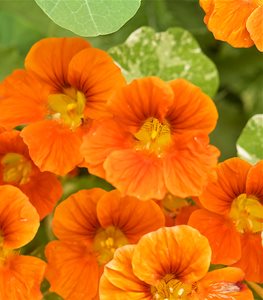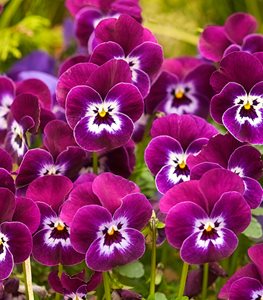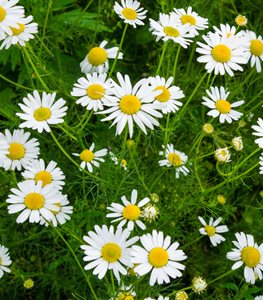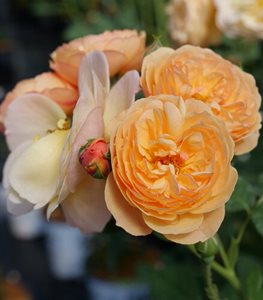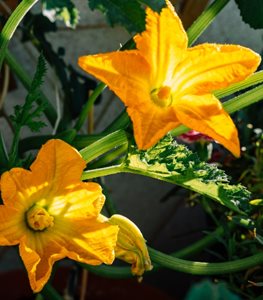15 Edible Flowers to Grow
Add visual appeal and fresh flavor to your meals with these common garden flowersIf you want to step up your cooking repertoire, incorporate edible flowers into your meals. Pretty as well as tasty, edible flowers add a touch of elegance to appetizers, salads, main dishes, beverages, baked goods, and desserts. Create memorable dishes for special occasions such as birthdays or anniversaries using edible flowers that your guests will be talking about long after the party is over.
It’s essential to research what flowers are edible before cooking or eating to make sure they aren’t toxic, or have other properties such as a bitter taste or prickly texture that make them unpalatable. The possibilities for using edible flowers are nearly endless, whether used as a decorative garnish, raw, cooked, or preserved. Here are some of the best edible flowers to grow and eat. On this page:
BEE BALM (Monarda spp.)
Zones: 3-9
Height/Spread: Upright spreading habit; 10 to 48 inches tall, 8 to 36 inches wide
Bloom time: Late spring to fall
Exposure: Full sun to partial shade
Taste: Minty citrus flavor
How to use: Harvest the flower petals and use as a colorful garnish, in salads or to decorate a cake or other dessert. Use for homemade butter and jams, brew into tea, or infuse in ice cream.
Bee balm is an ornamental herb related to mint that is used for a variety of culinary and medicinal purposes. The red, pink, lavender, or purple tubular flowers are a magnet for hummingbirds, bees, and other pollinators. The pungent leaves are also edible. Learn more about growing bee balm.
BEGONIA (Begonia spp.)
Zones: Most are hardy in USDA zones 9-11 and are grown primarily as an annual. Hardy begonias can survive to USDA zone 6.
Height/Spread: Upright, mounding or spreading habit; 8 to 24 inches tall, 12 to 24 inches wide
Bloom time: Late spring to frost
Exposure: Partial sun to shade
Taste: Tart, lemony flavor
How to use: The flower petals can be used to dress up a salad or as a garnish. Use for fish or other dishes that are complemented by lemon flavor. Add zest to soups, pastas, and cold drinks.
Edible types include tuberous begonias (Begonia x tuberosa) and wax begonias (B. cucullata). The stems and leaves are also edible. Avoid consuming any part of the plant if you suffer from gout, kidney issues, or rheumatism. Learn more about growing begonias.
BORAGE (Borago officinalis)
Zones: 2-11, grown as an annual
Height/Spread: Upright habit; 12 to 36 inches tall, 9 to 24 inches wide
Bloom time: Summer to fall
Exposure: Full sun to partial shade
Taste: Flowers taste similar to cucumber, with a slightly bitter aftertaste
How to use: The tiny flowers, which are best eaten fresh, add bright color when used as a garnish for appetizers, salads, soups, tea, and cold drinks. They can also be added to dips or cheese tortas, or candied and used as a decorative topping for desserts.
Also known as starflower, this quick-growing annual herb produces vivid sky-blue flowers. The leaves and seeds are used medicinally, but may cause problems for certain groups of people.
CALENDULA (Calendula officinalis)
Zones: 2-11, grown as an annual
Height/Spread: Upright bushy habit; 1 to 2 feet tall and wide
Bloom time: Late spring to fall
Exposure: Full sun to partial shade
Taste: Spicy, tangy or peppery, with a similar flavor to saffron
How to use: Sprinkle the brightly colored petals on salads, soups, pasta, rice, or poultry dishes. Add to herb butters and spreads.
Also known as pot marigold, this short-lived perennial or annual produces multi-petaled flowers in warm hues of orange, gold, yellow, and peach. The flower petals are the only part of the plant that is edible.
CHIVES (Allium schoenoprasum)
Zones: 3-9
Height/Spread: Mounding compact habit; 10 to 18 inches tall and wide
Bloom time: Late spring to early summer
Exposure: Full sun to partial shade
Taste: Mild, onion-like flavor
How to use: Flower heads are commonly used as a garnish for soups and salads. Chop and add to softened butter, cream cheese, dips, and spreads. Chive flowers taste good in omelettes, soups, stews, pastas, casseroles, breads, or muffins. Sprinkle fresh flower petals over eggs or crepes, or infuse in salad dressings, vinegar, or cooking oil.
This onion relative produces clover-like pale lavender-pink flowers. The grass-like stems are also safe to eat and are commonly chopped and added to a wide range of fresh and cooked dishes. Learn more about growing alliums.
DAYLILY (Hemerocallis spp.)
Zones: 3-9
Height/Spread: Upright clumping habit; 1 to 6 feet tall, 1 to 4 feet wide
Bloom time: Late spring to summer, with some varieties reblooming into fall
Exposure: Full sun
Taste: Mild and slightly sweet flavor, compared to asparagus, lettuce, melon, or zucchini. The taste of sautéed or steamed flower buds resembles young green beans.
How to use: Prepare and eat flower buds the same as you would young green beans, or add to stir fries. Flowers can be stuffed with soft cheese, rice or other savory filling and baked. Use the colorful blooms to decorate salads, platters, or cakes.
Daylily flowers come in nearly every color imaginable, making them a highly decorative edible accent. The young leaf shoots and tuberous roots are also edible. Eat in moderation to avoid digestive upset. Learn more about growing daylilies.
DIANTHUS (Dianthus spp.)
Zones: 3-9, depending on variety
Height/Spread: Upright, mounding or spreading habit; 4 to 36 inches tall, 4 to 24 inches wide
Bloom time: Spring to early summer, with some varieties blooming into fall
Exposure: Full sun to partial shade
Taste: Spicy clove or nutmeg-like flavor
How to use: Separate the edible petals from the base of the flower, which has a bitter taste. Petals can be crystallized with sugar and used to decorate cakes and other desserts. Fresh petals add color to cocktails and other cold drinks, fruit salad, or as a garnish to meat dishes or root vegetables. The spicy flavor pairs well with sweet or savory dishes.
Dianthus is a popular cottage garden perennial grown for the fringed flowers that occur in a range of colors. Edible species include sweet William (Dianthus barbatus) and carnation (D. caryophyllus). Avoid eating the stems and leaves, which may cause indigestion. Learn more about growing dianthus.
HIBISCUS (Hibiscus spp.)
Zones: 4-11, depending on species
Height/Spread: Upright bushy habit; 3 to 12 feet tall, 2 to 10 feet wide, depending on the variety
Bloom time: Summer to fall, with year-round bloom in tropical climates
Exposure: Full sun to partial shade
Taste: Citrusy cranberry-like flavor
How to use: Flower petals can be used as a garnish, in salads, syrups, or dried to make tea.
This herbaceous perennial, tropical annual, or hardy shrub is grown for the showy trumpet-shaped flowers that add an exotic touch to beds, borders, and containers. Learn more about growing rose mallow hibiscus or growing rose of Sharon hibiscus.
LAVENDER (Lavandula spp.)
Zones: 5-9
Height/Spread: Upright shrubby habit; 1 to 4 feet tall, 1 to 5 feet wide
Bloom time: Late spring to fall, depending on the species
Exposure: Full sun
Taste: The flavor of lavender is complex, and varies according to species and cultivars. Edible varieties have a sweet, floral taste with an undertone of earthiness and mint. Start out with a small amount and add to the desired taste, as too much can overwhelm a dish or recipe.
How to use: The uses for lavender flowers are nearly endless. Use to flavor cookies, breads and other baked goods; in syrups, tea, sorbet, ice cream, jelly, honey, and desserts. Add to stews, sauces, marinades, dried spice rubs, herbal mixtures, cocktails, and other chilled drinks.
This popular Mediterranean herb is grown for wide array of culinary, medicinal and ornamental uses. Flower spikes occur in shades of purple, lavender, blue, pink, yellow and white. English lavender (Lavandula angustifolia) is the best species for cooking, with a sweeter, milder taste than other types, which are more pungent and better suited for use in essential oils, sachets and fragrances. The best culinary lavender varieties include ‘Folgate’, ‘Grosso’, ‘Hidcote’, ‘Munstead’, ‘Provence’ and ‘Royal Velvet’. Learn more about growing lavender.
MARIGOLD (Tagetes spp.)
Zones: 2-11, grown as an annual
Height/Spread: Upright, mounding or bushy habit; 6 to 48 inches tall, 6 to 24 inches wide
Bloom time: Late spring until frost
Exposure: Full sun
Taste: Citrusy, peppery flavor; can be used as a substitute for saffron
How to use: Remove the white petal base, which can have a bitter taste. Combine fresh marigold petals with other brightly colored edible flowers such as nasturtium, borage and pansies for a festive garnish. Use marigold petals to decorate cakes or to flavor grilled meats, stews, soups, and salads. Infuse oil, vinegar, or wine with the petals.
Marigolds are a popular annual flower grown for the single or double flowers in shades of red, orange, gold, yellow and white. Some marigold species are edible, others are edible but distasteful, and some are harmful if eaten. The best edible marigolds include lemon or signet marigold (Tagetes tenuifolia) and Mexican mint marigold (T. lucida). Leaves may also be edible. Learn more about growing marigold flowers.
NASTURTIUM (Tropaeolum majus spp.)
Zones: 9-11, grown primarily as an annual
Height/Spread: Mounding, spreading, or vining habit; 1 to 10 feet tall, 1 to 3 feet wide
Bloom time: Summer to fall
Exposure: Full sun
Taste: Mild peppery flavor
How to use: Nasturtium blossoms make a colorful zesty addition to a wide array of dishes. Add whole flowers or petals to salads. Infuse the petals in oil or vinegar, or add to salad dressing. Use whole flowers to garnish platters, pasta dishes, and desserts. Stuff flowers with soft cheese or guacamole and serve with crackers as an appetizer.
One of the most popular edible flowers, this cool season annual produces trumpet-shaped flowers in a kaleidoscope of cheerful colors. The leaves and large rounded seeds are also edible.
PANSY (Viola x wittrockiana)
Zones: 7-10, grown primarily as an annual
Height/Spread: Compact or trailing habit; 6 to 9 inches tall, 9 to 12 inches wide, with trailing forms spreading 2 feet or more
Bloom time: Spring and fall, with winter bloom in milder climates
Exposure: Full sun to partial shade
Taste: Sweet perfumed or grass-like flavor
How to use: The brightly colored flowers can be candied and used as a decoration on cakes and other desserts. Use fresh flowers as a garnish or in salads. Petals can be pressed into soft cheese logs for a decorative appetizer, or frozen in ice cubes to dress up cocktails and other cold drinks.
This cool season annual or short-lived perennial is grown for the cheerful flat-faced flowers that come in a wide range of colors and patterns. Petals have a milder taste than the entire flower. Learn more about growing pansy flowers.
ROMAN CHAMOMILE (Chamaemelum nobile)
Zones: 4-9
Height/Spread: Creeping ground cover habit; 3 to 6 inches tall, 10 to 12 inches wide
Bloom time: Summer to fall
Exposure: Full sun to partial shade
Taste: Mild, sweet apple-like flavor
How to use: Chamomile flowers can be used fresh or dried. The sweet flavor makes chamomile suited to making jelly or desserts such as cakes, pastries, custards, and ice cream. Add flowers to cocktails, make a simple syrup, fruit-flavored cordial, liqueur, or herb-infused wine. Brown a few dried flowers in butter and add to oatmeal or other cooked cereal. Freshly cut flowers can be added to salads or salad dressing.
Chamomile is an herb widely known for its calming properties and medicinal benefits, and is most commonly used to brew tea. The leaves are also edible, with a more bitter taste. German chamomile (Matricaria recutita) is also edible.
ROSE (Rosa spp.)
Zones: 2-11, depending on type
Height/Spread: Bushy, mounding, spreading or climbing habit; 1 to 25 feet tall, 1 to 15 feet wide, depending on the type
Bloom time: Late spring to fall
Exposure: Full sun to partial shade; flowers best in full sun
Taste: The flavor, which varies depending on the rose type, can have fruity, minty or spicy undertones. Darker colored flowers tend to be more flavorful.
How to use: Sprinkle petals on salads and desserts, or freeze them in ice cubes to add to cocktails or other cold drinks. The petals can also be used to make butter, spreads, syrup, or jelly.
Roses are one of the most popular garden plants, with a wide array of flower colors and forms. The rose petals are the only edible part of the plant. Learn more about growing roses, and get rose petal recipe ideas.
SQUASH (Curcubita spp.)
Zones: 4-11; grown as an annual
Height/Spread: Bushy or vining habit; 1 to 12 feet tall and wide
Bloom time: Summer
Exposure: Full sun
Taste: Mild squash flavor with a light floral flavor
How to use: The most popular way to prepare squash blossoms is to stuff them with ricotta or other soft cheeses, coat with batter, and fry them. They can also be used as a garnish or added to salads, soups, quesadillas, pasta, and other main dishes.
Large bright orange or yellow flowers from zucchini, pumpkins, summer and winter squashes can be harvested and eaten. Plants produce both male and female flowers, with female flowers producing fruit. To preserve your squash harvest, pick only the male flowers, leaving a few to pollinate female flowers.
Male flowers are hairier with a thin stem at the base of the flower, while female blossoms have a bulge at the base where the fruit will develop. Harvest the flower buds before the flowers fully open and use the same day for optimal flavor and quality. Remove anthers, wash and dry the blossoms before using.
EDIBLE FLOWER TIPS

Learn how to use cheese with edible flowers.
Photo by: Proven Winners.
- Harvest flowers early in the day when the blooms are fresh and essential oils are most intense. Make sure flowers are free from bugs and refrigerate until you’re ready to use them. Use as soon as possible for the best quality.
- To wash flowers, dip them in a bowl of cold water and shake gently to dislodge dirt or bugs. Some flowers may be too delicate to wash.
- Before eating the flowers, remove pistils and stamens. Flowers such as nasturtium, chives and borage can be left intact.
- Never use pesticides or chemicals on any plants that you plan on eating. Don’t use flowers that have been purchased at a florist or garden center, as they may have been treated with chemicals that can be harmful if ingested.
- If you decide to forage for edible flowers in the wild, avoid harvesting flowers adjacent to roadsides, as they may contain pollutants.
- Eat edible flowers sparingly, as some people may experience digestive issues if they over-consume.
- Don’t use too many different types of flowers at once, as the individual flavors will be overwhelmed.
- Herb flowers tend to be more pungent than the leaves, so use them more sparingly.
- For tiny delicate flowers such as borage, use tweezers for easier handling, more precision, and to avoid damaging the flowers.
- Some plants have other parts that are edible, such as stems, leaves, fruits or tubers. Check to make sure these other parts are edible before consuming.
- If you have pollen allergies, avoid eating edible flowers, or proceed with caution.
RELATED:
24 Purple Flowers to Brighten Your Garden
32 Red Flowers for a Gorgeous Garden
34 Yellow Flowers for Your Garden
How to Start a Flower Garden

